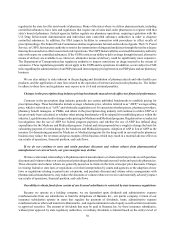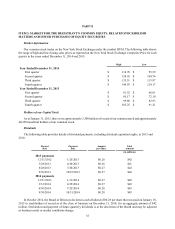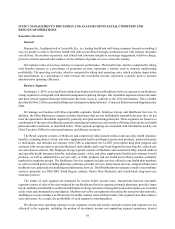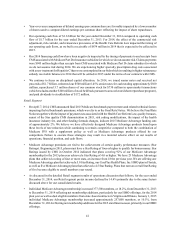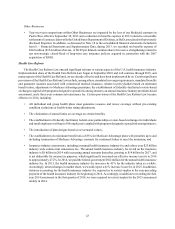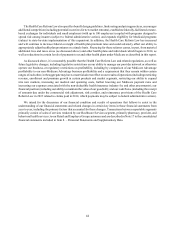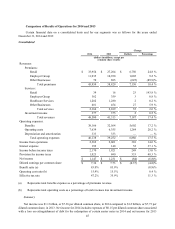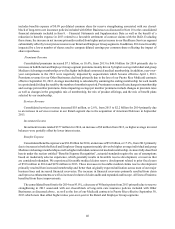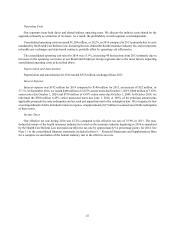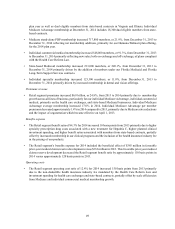Humana 2014 Annual Report Download - page 47
Download and view the complete annual report
Please find page 47 of the 2014 Humana annual report below. You can navigate through the pages in the report by either clicking on the pages listed below, or by using the keyword search tool below to find specific information within the annual report.39
ITEM 7. MANAGEMENT’S DISCUSSION AND ANALYSIS OF FINANCIAL CONDITION AND
RESULTS OF OPERATIONS
Executive Overview
General
Humana Inc., headquartered in Louisville, Ky., is a leading health and well-being company focused on making it
easy for people to achieve their best health with clinical excellence through coordinated care. Our strategy integrates
care delivery, the member experience, and clinical and consumer insights to encourage engagement, behavior change,
proactive clinical outreach and wellness for the millions of people we serve across the country.
Our industry relies on two key statistics to measure performance. The benefit ratio, which is computed by taking
total benefits expense as a percentage of premiums revenue, represents a statistic used to measure underwriting
profitability. The operating cost ratio, which is computed by taking total operating costs, which excludes depreciation
and amortization, as a percentage of total revenue less investment income, represents a statistic used to measure
administrative spending efficiency.
Business Segments
On January 1, 2014, we reclassified certain of our businesses from our Healthcare Services segment to our Employer
Group segment to correspond with internal management reporting changes. Our reportable segments remain the same
and prior period segment financial information has been recast to conform to the 2014 presentation. This is further
described in Note 2 to the consolidated financial statements included in Item 8. - Financial Statements and Supplementary
Data.
We manage our business with three reportable segments: Retail, Employer Group, and Healthcare Services. In
addition, the Other Businesses category includes businesses that are not individually reportable because they do not
meet the quantitative thresholds required by generally accepted accounting principles. These segments are based on a
combination of the type of health plan customer and adjacent businesses centered on well-being solutions for our health
plans and other customers, as described below. These segment groupings are consistent with information used by our
Chief Executive Officer to assess performance and allocate resources.
The Retail segment consists of Medicare and commercial fully-insured medical and specialty health insurance
benefits, including dental, vision, and other supplemental health and financial protection products, marketed directly
to individuals, and includes our contract with CMS to administer the LI-NET prescription drug plan program and
contracts with various states to provide Medicaid, dual eligible, and Long-Term Support Services benefits, collectively
our state-based contracts. The Employer Group segment consists of Medicare and commercial fully-insured medical
and specialty health insurance benefits, including dental, vision, and other supplemental health and voluntary benefit
products, as well as administrative services only, or ASO, products and our health and wellness products primarily
marketed to employer groups. The Healthcare Services segment includes services offered to our health plan members
as well as to third parties including pharmacy solutions, provider services, home based services, integrated behavioral
health services, and predictive modeling and informatics services. The Other Businesses category consists of our military
services, primarily our TRICARE South Region contract, Puerto Rico Medicaid, and closed-block long-term care
insurance policies.
The results of each segment are measured by income before income taxes. Transactions between reportable
segments consist of sales of services rendered by our Healthcare Services segment, primarily pharmacy, provider, home
based, and behavioral health, to our Retail and Employer Group customers. Intersegment sales and expenses are recorded
at fair value and eliminated in consolidation. Members served by our segments often utilize the same provider networks,
enabling us in some instances to obtain more favorable contract terms with providers. Our segments also share indirect
costs and assets. As a result, the profitability of each segment is interdependent.
We allocate most operating expenses to our segments. Assets and certain corporate income and expenses are not
allocated to the segments, including the portion of investment income not supporting segment operations, interest



